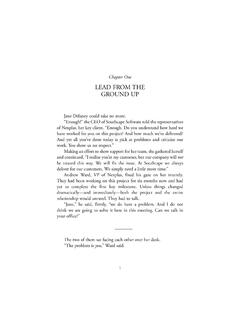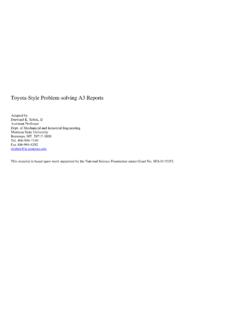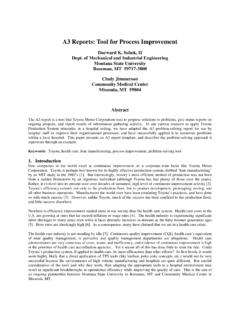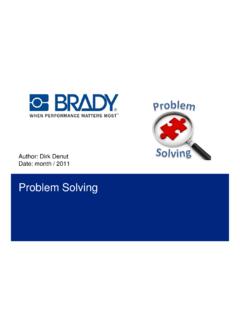Transcription of How To Compare Six Sigma, Lean and the Theory of ...
1 ITHIN THE AMERICAN businesscommunity a multitude of processimprovement champions arevying for leadership attention. Each champion advocates theadoption of his or her improve-ment methodology in your organization. Almost allplead that if you adopt their specific tools or followa specific way of thinking, all your business prob-lems will be solved. After listening to multiple champions advocatetheir special methodology, how do you choosewhat will be best for your situation? What method-ology fits the culture of your organization? Many process improvement methodologiesappear to conflict with each other or at least down-play the contribution of othermethodologies. This montage oftools and philosophies creates theillusion of conflicting this article, I will discuss thebasics of the three improvementmethodologies and present a modelto help you understand their con-cepts and effects and similaritiesand differences.
2 Table 1 describesthe essence of each PROGRESSIMARCH 2002I73 How To Compare Six Sigma, lean and the Theory of ConstraintsA framework for choosing what s best for your organizationby Dave NavePROCESS IMPROVEMENTSix SigmaSix sigma claims that focusing on reduction ofvariation will solve process and business using a set of statistical tools to understand thefluctuation of a process, management can begin topredict the expected outcome of that process. If theoutcome is not satisfactory, associated tools can beused to further understand the elements influenc-ing that process. Through a rigid and structured investigationmethodology, the process elements are more com-pletely understood. The assumption is the outcomeof the entire process will be improved by reducingthe variation of multiple sigma includes five steps: define, measure,WImprovement ProgramsTABLE 1 ProgramSix SigmaLean thinkingTheory of constraintsTheoryReduce variationRemove wasteManage constraintsApplication1.
3 Identify Identify Identify value Exploit Subordinate Elevate Repeat focusedFlow focusedSystems constraintsanalyze, improve and control(commonly known as DMAIC): Define. Practitioners begin bydefining the process. They askwho the customers are andwhat their problems are. Theyidentify the key characteristicsimportant to the customeralong with the processes thatsupport those key characteris-tics. They then identify exist-ing output conditions alongwith the process elements. the focus is onmeasuring the process. Keycharacteristics are categorized,measurement systems are veri-fied and data are collected. data are col-lected, it is analyzed. Theintent is to convert the rawdata into information that pro-vides insights into the insights include identi-fying the fundamental and most important causesof the defects or problems.
4 Fourth step is to improve the to the problem are developed, andchanges are made to the process. Results of processchanges are seen in the measurements. In this step,the company can judge whether the changes arebeneficial, or if another set of changes is necessary. the process is performing at a desiredand predictable level, it is put under control. Thislast step is the sustaining portion of the Six Sigmamethodology. The process is monitored to assure nounexpected changes on the primary area of variation reductionproduces other secondary effects, too. Quality isimproved. Process investigation produces the re-eval-uation of the value added status of many elements are modified, while others are discon-tinued.
5 Elements are refined and improved. Mistakesand opportunities for mistakes are elements discovered during the Six Sigmainvestigation constrain the flow of products or ser-vices through the system. Flow is defined as the timefrom the input of raw material to the output of a sal-able item. Improvement of a process that was restrict-ing flow results in reduced variation, better qualityand improvement in the volume of the process out-put. Thus the organization has less money tied up inin-process inventory. The time from paying for inputmaterial to seeing a profit is reduced, and the organi-zation can respond to cus-tomer needs more sigma is founded ontwo main , people in an organi-zation understand andappreciate the fact thatnumbers can representfeatures and characteris-tics of a process.
6 Theyappreciate that a deeperunderstanding of data anddata analysis can be usedto produce improvements,and graphical representa-tions of data can providenew and different per-spectives of the types, such asengineers and scientists,generally respect assumption isthat through the reductionof variation of all the processes, the overall perfor-mance of the organization will be improved. But whileit is hard to argue against improvement, the economicreality of business is we want the most improvementfor the least investment. Improving all of an organiza-tion s individual processes could actually have a detri-mental effect on the company s ability to satisfy thecustomer s needs and provide product and services atthe right time at the lowest cost.
7 The realized savingsto the system might be less than the cost of all theimprovements. So, an organization that improves things justbecause it can may be improving the wrong things forthe thinkingLean thinking is sometimes called lean manufactur-ing, the Toyota production system or other focuses on the removal of waste, which isdefined as anything not necessary to produce theproduct or service. One common measure is touch time the amountof time the product is actually being worked on, ortouched, by the worker. Frequently, lean s focus ismanifested in an emphasis on flow. There are five essential steps in lean : 1. Identify which features create Identify the sequence of activities called the Make the activities SigmaHOW TO Compare SIX sigma , lean AND THE Theory OF CONSTRAINTSThe assumption is the outcomeof the entire process will beimproved by reducing the variation of multiple Let the customer pull product or service throughthe Perfect the determination of which featurescreate value in the product is made from the internaland external customer standpoints.
8 Value is expressedin terms of how the specific product meets the cus-tomer s needs, at a specific price, at a specific products or services are evaluated on whichfeatures add value. The value determination can befrom the perspective of the ultimate customer or asubsequent process. Identify the value value is identified,activities that contribute value are identified. Theentire sequence of activities is called the value a determination is made as to whether activitiesthat do not contribute value to the product or serviceare necessary. Necessary operations are defined asbeing a prerequisite to other value added activities orbeing an essential part of the business. An example ofa nonvalue added but necessary process is all, people need to be paid.
9 Finally the impactnecessary, nonvalue added activities have on theprocess is reduced to a minimum. All other nonvalueadded activities are transitioned out of the value added activities and nec-essary nonvalue activities are identified, improvementefforts are directed toward mak-ing the activities flow. Flow isthe uninterrupted movement ofproduct or service through thesystem to the customer. Major inhibitors of flow arework in queue, batch processingand transportation. Thesebuffers slow the time from prod-uct or service initiation to deliv-ery. Buffers also tie up moneythat can be used elsewhere inthe organization and cover upthe effects of system restraintsand other wasted customer is removed and flowestablished, efforts turn to let-ting the customer pull productor service through the company must make theprocess responsive to providingthe product or service onlywhen the customer needs it not before, not toward is the repeated and con-stant attempt to remove nonvalue activity, improveflow and satisfy customer delivery lean focuses on removing waste and improv-ing flow, it too has some secondary effects.
10 Quality isimproved. The product spends less time in process,reducing the chances of damage or of processes results in reduction of vari-ation. As the company looks at all the activities in thevalue stream, the system constraint is removed, andperformance is lean methodology also makes some assump-tions: People value the visual effect of flow. Waste is the main restriction to profitability. Many small improvements in rapid succession aremore beneficial than analytical study. Process interaction effects will be resolved throughvalue stream in operations appreciate this involves many people in the value to flow thinking causes vast changes inhow people perceive their roles in the organizationand their relationships to the of constraints (TOC)TOC focuses on system improvement.




